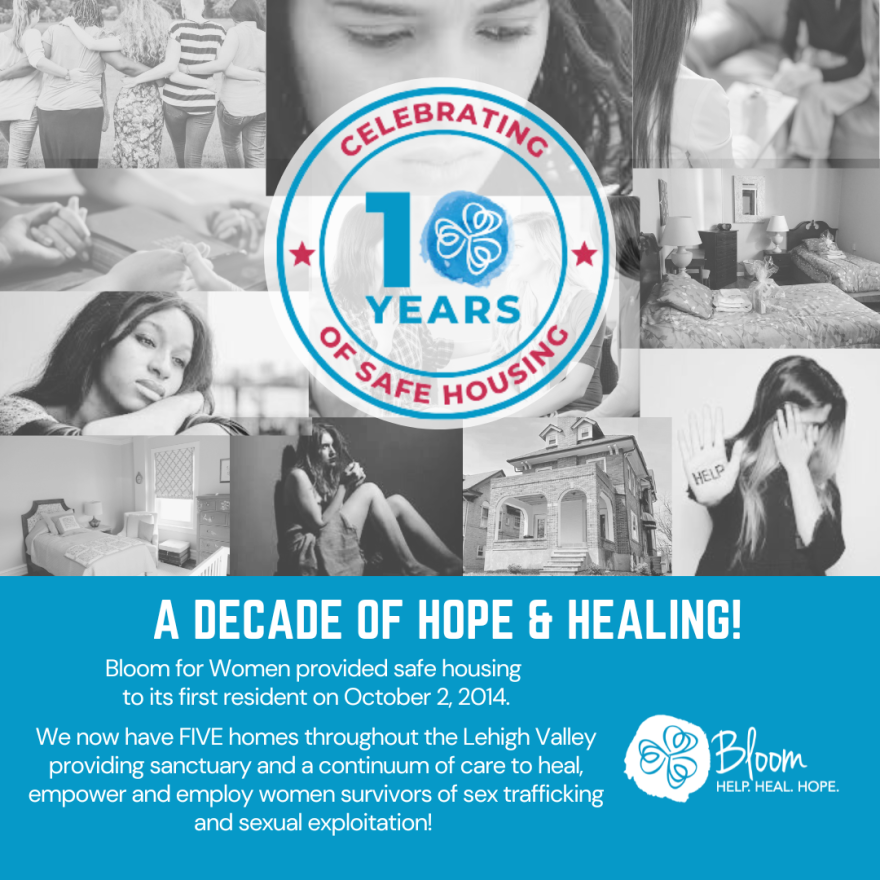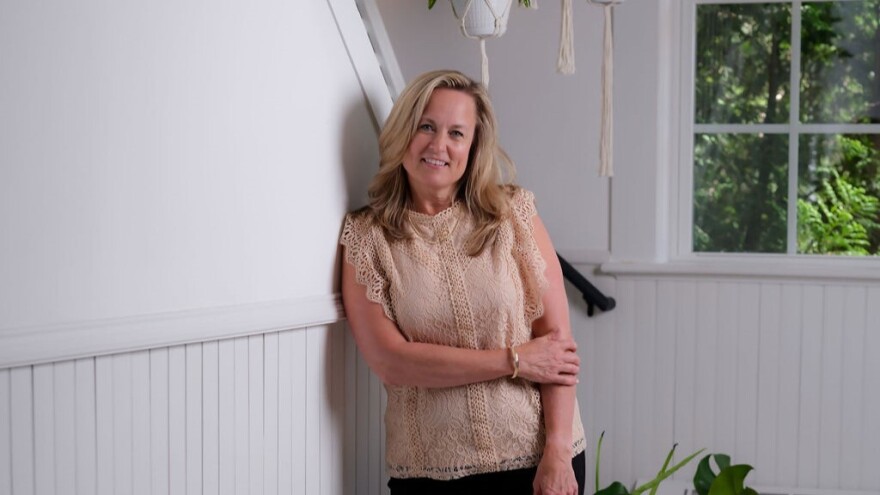BETHLEHEM, Pa. — The Lehigh Valley is growing in many ways — among the fastest-growing markets in the Northeast, with a population projected to increase more than 100,000 in the next 50 years, according to the Lehigh Valley Planning Commission.
And with that growth in the number of people, local experts and community leaders also have raised concerns that human trafficking is on the rise in Pennsylvania.
“What's unknown is that it is happening in our area.”Carol Andersen, CEO Bloom for Women
But a Bethlehem-based group is devoted to working to bring awareness of the problem in the Lehigh Valley and help those victimized by it.
“What's unknown is that it is happening in our area," said Carol Andersen, chief executive officer of Bloom for Women, a nonprofit that Bloom for Women has five homes throughout the Lehigh Valley and offers a comprehensive 2-year residential program for survivors.
January isNational Human Trafficking Awareness Month when federal agencies and human rights advocacy groups call for more awareness regarding human trafficking.
Human trafficking explored
The U.S. Justice Department says modern human trafficking laws draw from the Constitution's 13th Amendment barring involuntary servitude and slavery.
The U.S. House of Representatives has passed more significant legislation following recent trends.
“The majority of human trafficking often is sex trafficking,” Andersen said.
Few federal laws hold people accountable for trafficking, making it difficult for perpetrators to be caught, she said.
“Our mission is to provide sanctuary and the continuum of care, to heal, empower and employ victims.”Carol Andersen
"It's just an underground type of crime, very similar to illegal drug trade and illegal arms trade, often not noticeable,” she said.
Bloom, the organization Andersen spearheads, for several years has worked to deal with the growing issues around human trafficking.
“Our mission is to provide sanctuary and the continuum of care, to heal, empower and employ victims,” Andersen said.
It's estimated there are millions of victims of human trafficking globally, but Bloom prioritizes those victims in the Lehigh Valley, including through community outreach.
“It's happening because people reach out to us for support because they know that we're here," she said.
A Bloom program in Lehigh County Jail for the first time last year worked with more than 35 women.
Bloom has also operated and staffed the Bethlehem boutique My Sisters Closet, providing survivors employment opportunities since 2008.
"One of the things we want to do in 2025 is to really step up the awareness out there, in the public, and share more that this is happening.”Carol Andersen, chief executive officer of Bloom for Women
The organization also is ”reaching out on the streets, visiting encampments or working with other nonprofits that work with vulnerable populations in the unhoused," she said.
While doing that, "we are able to say what we do, and people begin to disclose when they realize there is a resource," Andersen said.
"One of the things we want to do in 2025 is to really step up the awareness out there, in the public, and share more that this is happening,” she said.

Called to action
Andersen said she began her road to sex trafficking prevention and rehabilitation when she began fostering children with her husband.
Her family fostered for several years, and over time she observed that some limitations on what women’s shelters could provide bled into other problems for vulnerable women.
Andersen said she discovered limited resources for women to get help, prompting her to eventually start Bloom for Women's own programs in 2016.
“Just like in the '70s, when domestic violence shelters and rape crisis help began their work through grassroots efforts, that is [where] we are today," she said.
"I think the challenges are funding, as well as getting victims to trust us. It can be difficult when you've been victimized by people who have power and influence because that is what happens.”
The organization merged with Truth for Women in 2021, which has devoted 10 years to providing support for victims.
“We work with other nonprofits that work with the unhoused, and we educate them on the options that we have for women and for working in the community with victims,” Andersen said.
Challenges and positive trends
Asked about challenges faced in the ongoing work against human trafficking in the Lehigh Valley, Andersen said securing funding to support victims was chief among them.
“One of the early challenges that continues to this day is that there are no federal funding revenue streams that support this sort of crime victim,” Andersen said.
"We're seeing things change when people are educated."Carol Andersen, Bloom
In the early stage of the human trafficking fight, awareness is increasing, but that does not always translate to legislation and funding for prevention, she said.
Some positive trends are emerging on the awareness front, she said.
The state Transportation Department has made efforts over the past several years to train its staff on the ways to identify and combat human sex trafficking, through its “End Human Trafficking” course.
The state offers resources, as well.
“I think that's really exciting in this, to see that the Department of Transportation, the [U.S.] Department of Homeland Security, the campaigns there are," Andersen said.
"We're seeing a national effort to use consistent language across the board to train officials as well as professionals.
“Even now, in some states, and I think the state of North Carolina, every bar and restaurant has to display a poster that gives a resource for human trafficking victims.
"And so we're seeing things change when people are educated."
More awareness messaging
Whether through a poster campaign or other media campaigns, Andersen said she has noticed increases in sex and human trafficking awareness messaging.
"It's not something that a small organization like ours can do on our own..."Carol Andersen, Bloom
"In the airports now across the country, in the bathrooms, you'll see posters that raise awareness back in the trafficking," she said.
"So I think these are really good things, and it's not something that a small organization like ours can do on our own, but that's good, and we use those consistent messages, as well."
Andersen also stressed that localizing awareness messaging and the availability of local resources is an important part of that trend.
"We do get referrals from the National Human Trafficking Hotline, but it's also when local people find out that there is a local resource," she said. "I think that's also helpful, too."
To find out more about, or contribute to, Bloom and its work, visit its website.


